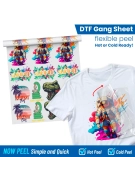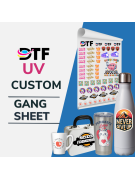What Printer can be Used for DTF Printing?

Welcome to the world of DTF printing! If you're reading this, you're probably curious about what DTF printing is and how it can be beneficial for your business or personal needs. DTF stands for Direct-to-Film, a relatively new technology in the digital printing industry. It's a technique that uses heat to transfer an image or design directly onto a material, often fabric, in a process that's faster and more efficient than traditional methods.
DTF printing is gaining popularity due to its high-quality results and versatility. It's a great solution for printing designs on a variety of materials, including those that are difficult to print on with other methods. So, if you're interested in learning about a cutting-edge printing technique that can take your designs to the next level, keep reading.
What are DTF Transfers?
DTF transfers are the heart of the DTF printing process. They are the images or designs that you want to print, which are initially printed on a special film. What makes DTF transfers unique is that they can be stored for a long period before being used, giving you flexibility in your printing process.
The DTF transfers are created using a unique ink and powder combination. The ink is used to print the design onto the film, and then the powder is applied. The powder serves as a bonding agent that allows the design to adhere to the material during the heat transfer process.
In essence, DTF transfers offer a high level of precision and color intensity, making them ideal for complex and colorful designs. They also provide excellent washability and stretchability, making them perfect for clothing and other fabric-based products.
Understanding the Use of a DTF Printer
Now that you understand what DTF transfers are, let's delve into the role of a DTF printer in the process. A DTF printer is a specific type of printer designed to print DTF transfers. Unlike regular printers, DTF printers use special inks and processes to produce high-quality, vibrant, and durable prints.
The DTF printer is crucial in providing the high-resolution images required for the DTF transfers. It prints your design onto the film using CMYK (Cyan, Magenta, Yellow, Black) and white inks. The white ink is essential as it helps the colors stand out on darker materials.
How does a DTF printer work?
The working process of a DTF printer is fascinating. It begins with the design creation, which can be done using various software tools. After creating your design, you need to print it using the DTF printer onto a specific type of film.
Once the design is printed on the film, a layer of adhesive powder is applied. The film is then cured in an oven, which melts the powder to create a smooth surface. This process transforms your design into a DTF transfer.
After the transfer has cooled, it's ready to be applied to your chosen material, such as a t-shirt or a hoodie. This is done using a heat press, which applies heat and pressure to the design, causing it to adhere to the material. Once the heat press is removed, your design is permanently affixed to the material, resulting in a high-quality, durable print.
How to Choose the Best DTF Printer
When it comes to choosing a DTF printer, several factors should be considered. First, consider the printer's resolution. Higher resolution printers typically produce better quality prints, but they also tend to be more expensive.
Second, look at the printer's speed. If you plan to do high-volume printing, a faster printer may be a good investment. However, keep in mind that speed often comes at the expense of quality.
Lastly, consider the printer's ink capacity. The larger the ink capacity, the longer you can print without having to refill the ink. This can be a significant time and cost saver, especially if you plan to do a lot of printing.
Choosing the "best" Direct to Film (DTF) printer depends on individual needs, budget, and project scale. As of April 2023, certain DTF printers have stood out for their exceptional performance, reliability, and output quality. Important considerations include print quality and resolution for detailed and vibrant prints, speed and efficiency for high-volume production, and compatibility with various fabrics and ink types. Additionally, evaluating the total cost of ownership, including inks, maintenance, and upgrades, is essential. Reliable customer support and a comprehensive warranty are also crucial for addressing any potential issues.
Maintenance and Care for DTF Printers
Proper maintenance and care for your DTF printer can significantly extend its lifespan and ensure consistent print quality. Regular cleaning is essential to prevent ink clogs and buildup. It's also crucial to use the correct type of ink and adhesive powder, as improper materials can harm the printer and affect print quality.
In addition to regular cleaning, routine inspections are essential. Check for any signs of wear or damage and replace any worn parts promptly. Regularly updating the printer's software is also crucial to ensure optimal performance.
Benefits of Using DTF Transfers in Printing
DTF transfers offer several benefits over traditional printing methods. First, DTF transfers produce high-quality, vibrant prints with excellent durability. They are also versatile and can be used on a wide range of materials, including those that are traditionally challenging to print on.
Moreover, DTF printing allows for low-volume, customized printing, making it ideal for small businesses or individual artists. With DTF printing, you can print one-off designs or small quantities without the high costs usually associated with traditional printing methods.
Cons of Using a DTF Printer
DTF Printers offer quality and flexibility in textile printing but come with notable drawbacks. The initial cost is high, covering the printer, inks, films, and adhesives, challenging for small operations. A significant issue is the lack of technical support in the USA, as most printers are imported from China, complicating troubleshooting. The steep learning curve and maintenance requirements, including regular cleaning to prevent clogging—especially since they can clog within 2-3 days of inactivity—add to the operational challenges. Printer heads are expensive to replace, increasing long-term costs. Additionally, DTF Printers require a well-ventilated space. Users must consider these factors, including cost, support, and maintenance, before investing in DTF Printing technology.
Case Study: Successful Businesses Using DTF Printers
Many businesses have found success using DTF printers. A prime example is a small clothing brand that started using DTF printing to produce custom designs. By using a DTF printer, they were able to offer unique, personalized products that set them apart from their competition. This helped them attract a loyal customer base and grow their business significantly.
Another success story is that of a promotional products company. By incorporating DTF printing into their operations, they could offer high-quality, full-color prints on a variety of products. This enabled them to expand their product range and attract new customers.
Conclusion: Is a DTF Printer Right for You?
In conclusion, a DTF printer could be a game-changer for your business or personal projects. With its high-quality prints, versatility, and cost-effectiveness, DTF printing offers numerous benefits. However, it's essential to consider factors like the printer's resolution, speed, and ink capacity when choosing a DTF printer.
Whether you're a small business owner looking to offer personalized products, an artist looking to sell your designs, or someone who enjoys DIY projects, a DTF printer could be the perfect tool for you.
At DTF Transfers Now, we are committed to offering you the best quality possible, our machines are constantly in use and checked for better outcomes.
So why wait? Start your own DTF business! Explore the world of DTF printing and see how it can elevate your work to new heights.





Leave a comment